
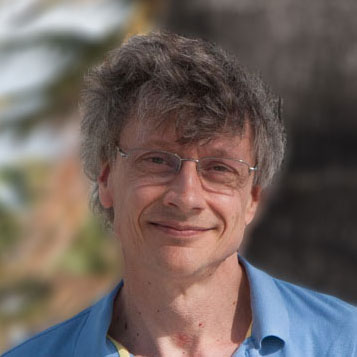
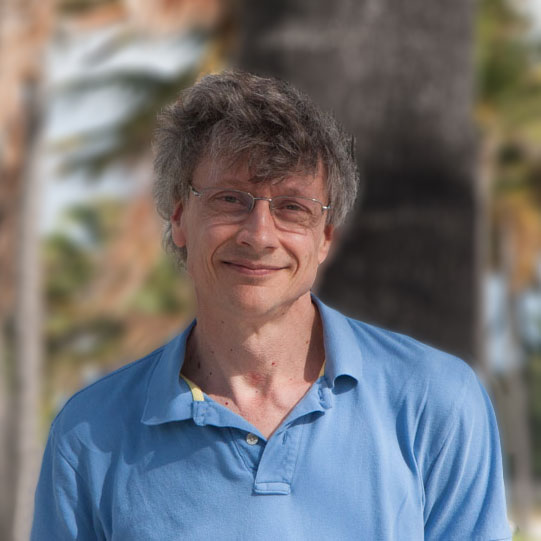 Robert
Kendall is a composer, writer, photographer, and Web artist. His music has been performed at Bargemusic
in New York City and elsewhere. ConcertoNet has described his music as "masterful,
dextrous,
supremely accomplished,"
going on to say "the sounds were luscious, the melodies were rich and warm-hearted."
His music was included in an interactive art installation
exhibited at Figment Boston 2018.
Robert
Kendall is a composer, writer, photographer, and Web artist. His music has been performed at Bargemusic
in New York City and elsewhere. ConcertoNet has described his music as "masterful,
dextrous,
supremely accomplished,"
going on to say "the sounds were luscious, the melodies were rich and warm-hearted."
His music was included in an interactive art installation
exhibited at Figment Boston 2018.
His photographs have appeared in several publications and Websites.
He began creating interactive multimedia poetry in 1990, making him one of the earliest practitioners of the form. He is the author of a book-length hypertext poem, A Life Set for Two (Eastgate Systems, 1996). His hypertext poetry has also appeared on disk in The Little Magazine and Version Box. It has appeared on the Web at Iowa Review Web, BBC Online, Eastgate Hypertext Reading Room,Cauldron & Net, and Cortland Review. A Wandering City (Cleveland State University Poetry Center, 1992), his printed book of poems, won the CSU Poetry Center Prize. Kendall's printed poetry has appeared widely in magazines (including Rattapallax,Contact II, River Styx, New York Quarterly, Barrow Street, and Indiana Review), and several anthologies have included his work. He has received a New Jersey State Council on the Arts Fellowship for literature and a New Forms Regional Grant Program Award.
Kendall has read his poetry at numerous locations in many states and in Europe, as well as on Manhattan Cable TV and nationally syndicated public radio. His electronic poetry has been exhibited at many sites in the USA (including the Franklin Institute Science Museum in Philadelphia and the Dodge Poetry Festival in Waterloo, New Jersey), as well as in England, France, Germany, Italy, Denmark, Switzerland, Australia, the Philippines, and Brazil. A videotape version of the work was shown at the Second Annual Poetry Video Festival in Chicago and on Manhattan Cable TV. Kendall curated an exhibit of digital and interactive artwork for the Painted Bride Art Center in Philadelphia, which included his own work.
Kendall has given many talks about interactive literature and electronic publishing at conferences and festivals, including conferences of the ACM and AWP. Since 1995 he has taught hypertext poetry and fiction through the online program of the New School University in New York. Over 100 of his articles and essays about computer technology and computers in the arts have appeared in publications ranging from PC Magazine, PC Computing, and Electronic Musician to Poets & Writers Magazine, Leonardo, Electronic Book Review, Cortland Review, Kairos, and Without Covers (a collection of essays from Purdue University Press). His papers have appeared in the proceedings of two ACM Hypertext conferences, one Digital Arts and Culture conference, and two Small Computers in the Arts symposiums. He was formerly the hypertext literature editor of the SIGWEB Newsletter (published by the Association for Computing Machinery), for which he wrote a regular column. His Web site Word Circuits publishes hypertext literature and offers a host of literary resources.
He served for many years on the Board of Directors of the Electronic Literature Organization and is the founder and original director of the Organization's Electronic Literature Directory. He is codeveloper of Connection Muse, an adaptive hypertext authoring system for Web poetry and fiction. His papers are archived by Duke University.
Kendall was born and raised in Canada. He earned an MA from New York University, sojourned in New Jersey and San Francisco, and now lives in Boston.
Contact him at kendall@wordcircuits.com.

Our deeply ingrained need to trust language enables Feed to generate an endless simulacrum of social commentary cum mythopoeic narrative spontaneously from largely random associations of charged words. With each click of the Continue button, it presents cultural observation through the blind eye of chance. The blank passing moment becomes the creator of mythos. It allows us the opportunity to turn ambiguity into poetry, absurdity into satire, unexpected fortuitous alignments into insight. Feed chronicles the mechanisms of the chronicle rather than its subjects. It removes “realism” from the equation, flirting with the meaningless and parading arbitrary associations before the reader under the banners of archetype and metaphor. Feed historicizes, editorializes, moralizes, sings, dances, and wears funny hats, all in the name of “analyzing” its own inventions.
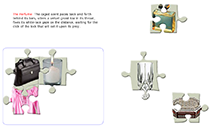
Pieces is a puzzle story. To read the work, you assemble the pieces of a jigsaw puzzle, each piece yielding a portion of narrative. Under your hands, several lives take shape in earnest if sometimes wobbly and unprepossessing assemblages. The manner in which you put the pieces together affects the course of the characters’ lives, different configurations resulting in different outcomes.
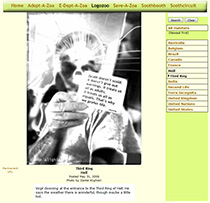
Logozoa.com is a home for textual organisms in the form of aphorisms, anti-aphorisms, maxims, minims, neokoans, sayings, left-unsaids, proverbialisms, poemlets, microtales, instant fables, and other varieties of conceptual riffs. They can be adopted as downloaded printable stickers or viewed as photos in a natural-habitat zoo.
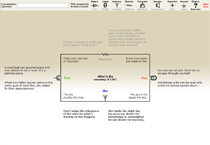
Soothcircuit presents constellations of Logozoa (see above) in the guise of oracular prognostication.
This animated poetry video confronts the fear of growing older but not necessarily wiser. Flash setting by Michele D'Auria. Narration by the author. (Requires Flash)
In the Garden of Recounting lets you tend and nurture memories that grow into a story. You are presented with a garden to explore, and as you move your mouse over the vegetation, lines of text sprout from it. Throughout this process, you can also “water” the garden with commentary that drips down from an overhanging cloud when you mouse over a set of keywords. The work metaphorically represents the process of coaxing fragmentary images out of memory in order to piece together an account of the past. It also demonstrates the way that memories change organically over time and how they can mutate in order to meet the needs of the story one wants to tell about oneself. This digital garden compels you to recognize that the acts of recalling and recounting are dependent not upon a fixed body of data but upon continually growing and changing organic structures within the brain. (Requires Flash)
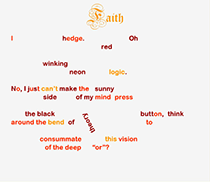
Faith is a kinetic poem that reveals itself in five successive states. Each new state is overlaid onto the previous one, incorporating the old text into the new. Each new state absorbs the previous one while at the same time engaging in an argument with it. The gradual textual unfolding is choreographed to music.
(Requires Flash)
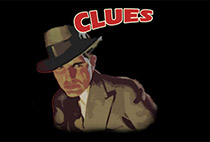
Clues explores the nature of communication, knowledge, and identity through the language and postures of mystery fiction. It's a metaphysical whodunit that invites you to solve the mystery by uncovering clues linked to images throughout the work. The search becomes a game that leads you down wooded trails, back alleys, and empty hallways. Which characters should you pursue? Which objects should you investigate? To win the game, you must separate all the clues from the red herrings. Your final score determines the outcome of the text. But is the mystery really soluble? Is winning actually better than losing? Are the answers or the questions more revealing?
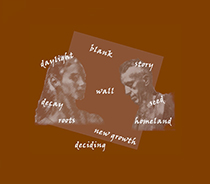
Penetration (2000) and Dispossession (1999)
Penetration explores change. The immigrant’s experience of changing
homelands, the seasonal changes within those lands themselves, and evolving
states of mind are counterpointed against one another and against the shifting
hypertextual structure of the poetry. The poem focuses on two immigrants from
Eastern Europe, a father and daughter, who are seeing each other again for the
first time in many years. The natural world around them becomes a third
character, the Mothering Earth. The hypertext unfolds organically from the
reader’s choices, with each different reading emphasizing different aspects
of the relationship. Many pages in the work contain variable text, which
changes whenever the reader rereads that page. The changeability of the text
reflects the constant flux of the relationships explored in the poem. Dispossession
follows a man who is leaving
his Caribbean homeland for America. The uncertainty of the future is
represented by the changeable structure, which places recurring images in
contrasting contexts.
A Study in Shades explores the devastation of Alzheimer’s Disease from the points of view of a man afflicted by it and his daughter. The reader interacts with the poem to experience the different perspectives of the two characters and their relationship to each other. An interplay between text and morphing graphics reflects the progress of this relationship.
A Study in Conveyance delves into the pleasures and dangers of letting yourself go.
In Frame Work, the interplay among texts in different frames of the browser explores the way the mind refocuses among modes of perception. The focus shifts from images inside a room to those outside a window.

A book-length hypertext poem that no longer runs on modern computers.
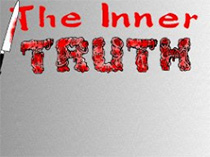
Kinetic visual poetry for DOS. These are among the earliest poems of this type ever written, but they no longer run on modern computers.
Sostenuto for Strings
Concerto for Perfection
Kinderscenen
Sonata for Unaccompanied Being
Impromptu on the Incomplete
A series of 5 visual poems based on music imagery.
Poems published in various online magazines.
Excerpts from the printed collection (Cleveland State University Poetry Center, 1992), winner of the CSU Poetry Center Prize
Discussion by three new media editors of the nontraditional roles they must take on in preparing new media literature for publication (Proceedings of 5th International Digital Arts and Culture Conference, Melbourne, 2003)
How the Electronic Literature Directory is meeting the unique bibliographic and typological challenges presented by electronic literature (fineArt forum, 2003; also in Proceedings of 5th International Digital Arts and Culture Conference, Melbourne, 2003)
Discussion of Connection Muse, an adaptive hypertext system for poetry and fiction (Proceedings of the Eleventh ACM Conference on Hypertext and Hypermedia, San Antonio, Texas, 2000)
Reflections on the appeal of electronic literature and the inherent relationships between poetry and computer code (The Cortland Review, Sept. 1999)
A look back at three years of teaching hypertext for the New School, along with samples of student work (Kairos, Fall 1998)
What does the Web mean for the future of creative writing? (Poets & Writers Magazine, Sept./Oct. 1998)
Discussion of some important issues concerning the present and future of hypertext poetics (Electronic Book Review, Spring 1997)
How hypertext can capture thought processes (Leonardo, June 1997)
This introduction to my hypertext poem A Life Set for Two explores the motivations for writing interactive poetry (The Eastgate Quarterly Review of Hypertext, Vol. 2, No. 4, Fall 1996)
Detailed discussion of how dynamic hypertext can emulate some of the workings of the mind (Proceedings of the Seventh ACM Conference on Hypertext, Washington, DC, 1996)
A look at hypertext and multimedia literature and its significance for the future of writing (Poets & Writers Magazine, Nov./Dec. 1995)
The exhibition guide for an exhibit of digital art that I curated (The Painted Bride Art Center, 1995)
Discussion of my work with multimedia poetry (The Thirteenth Annual Symposium on Small Computers in the Arts: Program and Proceedings, 1993)
This column on hypertext literature appears regularly in print in the SIGWEB Newsletter (formerly SIGLINK Newsletter) and online at Word Circuits.
Hypertext and print prove to be more compatible with one another than you might expect.
An ambitious new project defines a new approach to keeping tabs on hypertext literature.
How can we get a grip on the temporality of hypertext structure?
What are the elements of good hypertext?
Thematic transformation is the driving force behind this hypertext novella.
Hypertext writers must cope with the dangers of software obsolescence.
What can poets and fiction writers learn from the testing lab?
What can literature do for computer science?
For half a century, Theodore and Renée Weiss have presided over the evolution of one of the country's most influential journals (Poets & Writers Magazine, Mar./Apr. 1993)
A look at the PBS-featured biennial marathon that inspires hope for the future of poetry in America (Poets & Writers Magazine, Sept./Oct. 1991)
An essay about . . . well, read it and see (Black Swan Review, No. 3, 1990)
This article concludes with my response to a question about interactivity (NYFA Current, April 15, 2003)
One of several interviews of e-poets (Currents in Electronic Literacy, Fall 2001)
An interview by C.K. Tower and Jennifer Ley, accompanied by a review of A Life Set for Two (Perihelion, Fall 1998)
An on-line interview by Judy Malloy and others (The Interactive Art Conference on Arts Wire, April 1997)
Labyrinth:: A canon based on permutations of a single theme.
Invocation and Dance: A canon based on a second theme.
Scherzo: A canon that combines permutations of the themes from the first two movements.
A musical representation of the myth of Aeolus from Homer's Odyssey.
The Floating Island of Aeolia: Odysseus arrives at the floating island of Aeolia, home of Aeolus, Keeper of the Winds. He captivates his host with tales of his adventures.
Aeolian Harp: The wind sings to the accompaniment of the Aeolian Harp.
Homeward Blown: Aeolus provides Odysseus with a favorable wind that carries him and his fleet to within sight of their homeland.
Odysseus's Lament: While Odysseus slept, his men opened a sack containing fierce winds that blew the ships back to Aeolia. The Greeks now lament their misfortune and beg Aeolus to help them once more.
The Four Winds: Aeolus refuses to aid Odysseus a second time, so his ships are left to the vagaries of the four winds.
Each movement is based on a technique derived from painting. The piece is meant to be performed with the players seated at successively greater distances from each other as they perform each successive movement.
Each movement is a chapter from a musical mystery. In the final movement, important material from the first two movements returns and undergoes surprising transformations.
Each movement represents one of the four elements of classical philosophy: air, earth, water, and fire. There is a canon or fugue in each movement.
Air: The middle section is a fugue. The word "fugue" derives from the Italian word for flight, making this form all the more appropriate for a piece about soaring, floating, and drifting.
Earth: The opening section unfolds over a ground bass (a repeated melody in the bass), then the solo instrument takes up the ground bass theme. The middle section is a canon in 2 and 3 parts.
Water: The middle section is a canon.
Fire: A loosely structured double fugue (that is, one with two subjects, or themes). Each subject is treated in inversion (upside down), augmentation (with lengthened note values), and stretto (overlapping entries).
For the victims of COVID-19. An elegy in memory of those who fell during the century's worst global tragedy. The piece is a mixture of sorrow for what passed and anger at what didn't have to be.
Based on the dances of the classical Baroque suite.
Sunlight and Destiny:: Canon based on the first theme in original form.
Into the Sky: A canon based on the second theme in various permutations.
Scherzo: A canon that combines the first and second themes in various permutations.
Ending: A canon based on the first theme in various permutations.